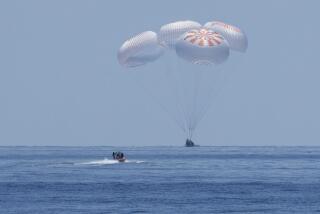Astronauts Lose Weight Quickly in Space, Medical Data Shows
- Share via
KENNEDY SPACE CENTER, Fla. — Astronauts quickly lose weight in space and return to Earth a little slimmer than when they left, scientists said Thursday in releasing findings from NASA’s most elaborate medical research mission.
National Aeronautics and Space Administration scientist Carolyn Leach said that each of the seven astronauts who flew aboard the shuttle Columbia in June lost up to six pounds after a day in orbit. As the nine-day mission wore on, they gained back all but two to three pounds, she said.
It was the first time that astronauts had measured their body masses shortly after reaching orbit, Leach said.
The weight loss is one of a number of rapid body changes observed during the flight. Scientists speculate that some of these changes may occur even before astronauts get off the ground.
“It may well be that the launch position, which is a head-down, legs-up position, and the acceleration forces across the chest . . . accelerate the adaptation” of the cardiovascular system, said Dr. C. Gunnar Blomquist of the University of Texas’ Southwestern Medical Center in Dallas. “The rapid adaptation may be unique to this particular mode of transportation.”
The crew consumed 70% less fluid and food on the first flight day, Leach said. That probably was partly because most of them were stricken with space motion sickness, she said.
Among the biggest surprises found was the reduced production of red blood cells in bone marrow.
Scientists want to better understand how the body reacts to space in preparation for longer spaceflights. NASA’s first two-week shuttle trip is scheduled for next summer.
Scientists reported also that 29 rats taken on the flight gained the same amount of weight as a control group on the ground. Although the bones of the space rats grew normally, the bone strength was less than expected.
Columbia also carried 2,478 tiny jellyfish. Those that matured developed gravity receptors to maintain direction and balance just as they would have on Earth, said Laurence Young of the Massachusetts Institute of Technology.






